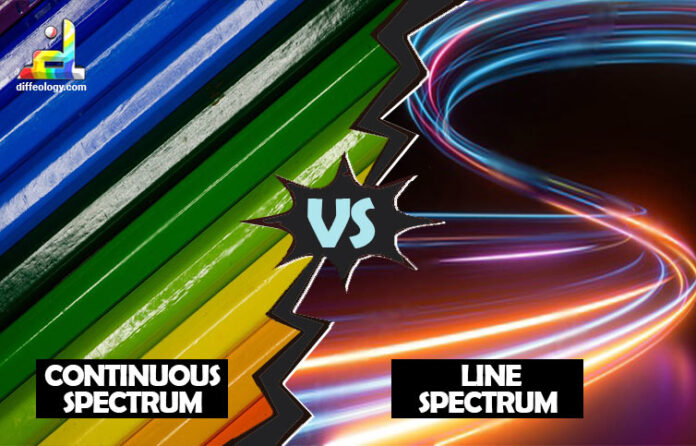When we look up at the sky on a bright sunny day, or gaze at the colorful lights of fireworks on a special occasion, we might not realize it, but we’re witnessing something incredible: the magic of light. Have you ever wondered why some lights make a rainbow of colors, while others just show a few bright lines? Well, that’s where continuous spectra and line spectra come into play. Also, there is a big Difference Between Continuous Spectrum and Line Spectrum.
Imagine you’re painting a picture, and you have two kinds of paint: one that smoothly blends from one color to another, and another that only lets you paint dots of specific colors. Similarly, light can be like these paints, spreading out smoothly across all colors or showing up as distinct dots at certain spots. So, let’s dive in and discover the fascinating world of continuous and line spectra!
Main Difference Between Continuous Spectrum and Line Spectrum
A continuous spectrum consists of an uninterrupted band of colors. Yet, a line spectrum consists of distinct lines or bands of color. A continuous spectrum is emitted by a hot, dense object like an incandescent light bulb. But a line spectrum is emitted by excited atoms or molecules.
A continuous spectrum contains all wavelengths of light within a certain range. However, a line spectrum contains only specific wavelengths corresponding to the energy transitions of the emitting atoms or molecules. A continuous spectrum appears as a smooth, unbroken sequence of colors, while a line spectrum appears as discrete lines or bands separated by gaps.
Continuous Spectrum Vs. Line Spectrum
What is a Continuous Spectrum?
A continuous spectrum is like a rainbow of colors that you see when sunlight passes through a prism. When white light, such as sunlight, goes through a prism, it breaks apart into all the colors of the rainbow: red, orange, yellow, green, blue, indigo, and violet. Each color blends seamlessly into the next, creating a smooth transition from one color to another. This blending is what makes the spectrum “continuous.” In simpler terms, it’s like having all the colors of the rainbow spread out in a line, with no gaps in between.
Read Also: Difference Between Distance and Displacement
In science, a continuous spectrum refers to a range of colors or wavelengths without any interruptions or gaps. It’s often seen in objects that emit light or radiation, such as stars or hot, glowing metals. Unlike other types of spectra that show distinct lines or bands, a continuous spectrum is like a smooth, unbroken flow of color. It’s an essential concept in understanding how light and energy behave in the universe, helping scientists learn about the composition and temperature of objects emitting light.
What is a Line Spectrum?
A line spectrum is a way of representing light or other electromagnetic radiation. Imagine you’re looking at a rainbow made by shining sunlight through a prism. Instead of seeing a smooth blend of colors like in a rainbow, a line spectrum breaks down the light into individual lines or stripes of specific colors. Each line represents a different wavelength of light, which corresponds to a specific color. It’s like seeing the light split into its component parts, with each part showing up as a distinct line in the spectrum.
Read Also: Difference Between Kinetic Energy and Potential Energy
This concept is crucial in various fields, from astronomy to chemistry. For instance, in astronomy, scientists use line spectra to study the composition of stars and galaxies by analyzing the unique patterns of lines in the light they emit. In chemistry, line spectra help identify different elements because each element produces its own distinct pattern of lines when it interacts with light. So, line spectra are like fingerprints for elements, allowing scientists to identify what substances are present in a sample just by studying the patterns of lines in the spectrum.
Comparison Table “Continuous Spectrum Vs. Line Spectrum”
| Definition | Contains all wavelengths in a range. | Composed of distinct, separated lines. |
| Nature | Appears as a smooth, unbroken band. | Consists of isolated, individual lines. |
| Source | Emitted by hot, dense objects. | Produced by specific elements or compounds. |
| Formation | Results from thermal radiation. | Generated by electron transitions. |
| Example | Incandescent light bulb emits it. | Neon sign produces it. |
| Appearance | Displays a rainbow of colors. | Exhibits distinct colors or lines. |
| Absorption Spectrum | Shows continuous absorption bands. | Reveals absorption lines at specific wavelengths. |
| Explanation | Due to the emission of photons across a broad spectrum of energies. | Arises from electrons moving between specific energy levels in an atom or molecule. |
| Application | Used in astronomy to study stars’ composition. | Employed in chemistry for identifying elements. |
| Instruments | Spectrometer, prism, or diffraction grating. | Spectroscopes or spectrometers. |
| Spectral Analysis | Analyzes intensity variations across a range of wavelengths. | Examines the presence and intensity of individual spectral lines. |
| Energy Distribution | Distributes energy continuously. | Concentrates energy at specific wavelengths. |
| Resolution | Lower resolution due to blending of wavelengths. | Higher resolution, providing precise wavelength information. |
| Bandwidth | Wide bandwidth. | Narrow bandwidth. |
| Complexity | Generally simpler to interpret. | Often more complex due to multiple lines. |
| Utility | Useful for understanding thermal radiation and broad-spectrum emissions. | Essential for identifying atomic and molecular constituents in substances. |
Difference Between Continuous Spectrum and Line Spectrum in Detail
1. Nature of Light:
A continuous spectrum is like a rainbow, showing all the colors blending smoothly together. Imagine you’re painting a picture and you smoothly blend one color into another without any breaks or gaps. That’s what a continuous spectrum is like. On the other hand, a line spectrum is more like dots of colors on a canvas. Each dot represents a specific color, and there are gaps in between where there’s no color. It’s like painting with a stencil, where you only get specific points of color.
2. Source of Light:
Continuous spectra usually come from hot, dense objects like stars or glowing pieces of metal. These objects emit light across a wide range of wavelengths. In contrast, line spectra often come from cooler, less dense objects, or from a gas. They emit light only at certain specific wavelengths, like how a particular kind of firework might give off only certain colors.
3. Composition:
A continuous spectrum contains all possible wavelengths of light within a certain range. It’s like having all the colors in a big box of crayons. However, a line spectrum only contains specific wavelengths of light, like picking out certain crayons from the box. Each line represents a specific color or wavelength.
4. Appearance:
Imagine you’re looking at a lamp through a prism. If the light forms a continuous spectrum, you’ll see a smooth band of colors. But if it’s a line spectrum, you’ll see distinct lines of color separated by dark spaces. It’s like comparing a gradient to a series of dots.
5. Origin:
Continuous spectra come from objects that are hot and dense enough to emit a wide range of light wavelengths. This could be anything from a burning candle to the surface of the sun. Line spectra, on the other hand, often come from cooler objects or from a gas. For example, when certain elements are heated or excited, they emit light in specific wavelengths, creating line spectra.
6. Applications:
Continuous spectra are used in various applications like analyzing the composition of stars, understanding the properties of hot objects, and in technologies like spectroscopy. Line spectra are particularly useful in identifying elements present in a substance, helping scientists figure out what something is made of by studying its unique spectral lines.
7. Observational Tools:
To observe a continuous spectrum, you might use a prism or a diffraction grating to spread out the light into its different colors. But to observe a line spectrum, you’d often use a spectroscope, a device that can detect and analyze the specific wavelengths of light emitted by a substance.
8. Energy Distribution:
In a continuous spectrum, the energy is spread out smoothly across all wavelengths, like a continuous flow of water in a river. In contrast, in a line spectrum, the energy is concentrated at specific wavelengths, like water spurting out of a fountain at certain intervals.
9. Representation:
Continuous spectra are often represented graphically as smooth curves, showing how intensity changes with wavelength. Line spectra are represented as discrete lines on a graph, indicating the specific wavelengths where light is emitted or absorbed. It’s like comparing a smooth hill to a series of distinct peaks on a graph.
Key Points Showing the Difference Between Continuous Spectrum and Line Spectrum
- Energy Levels: Continuous spectrum doesn’t involve quantized energy levels, while line spectrum is a result of transitions between quantized energy levels.
- Intensity: Continuous spectrum typically has varying intensities across different wavelengths, while line spectrum lines usually have uniform intensities.
- Width: Continuous spectrum has a broad width, covering a wide range of wavelengths, while line spectrum lines are narrow and concentrated at specific wavelengths.
- Applications: Continuous spectrum is commonly observed in thermal radiation and everyday light sources, while line spectrum is used in spectroscopy to identify elements and molecules.
- Origin: Continuous spectrum arises from thermal radiation of blackbody radiation, while line spectrum arises from the emission or absorption of photons by atoms or molecules.
- Complexity: Continuous spectrum is simpler in appearance and composition compared to line spectrum, which is more complex due to its discrete lines.
- Information: Continuous spectrum doesn’t provide detailed information about atomic or molecular properties, while line spectrum provides information about the energy levels and transitions within atoms or molecules.
- Energy Conservation: The continuous spectrum represents a continuous distribution of energy, while the line spectrum demonstrates discrete changes in energy levels.
- Structure: Continuous spectrum doesn’t exhibit distinct patterns or structures, while line spectrum often displays characteristic patterns unique to each element or molecule.
- Resolution: Continuous spectrum can be resolved into individual colors using a prism or diffraction grating. Line spectrum requires higher resolution instruments to distinguish closely spaced lines.
- Interference: Continuous spectrum can undergo interference phenomena like diffraction. Line spectrum is less susceptible to such interference due to its discrete nature.
- Observational Techniques: Continuous spectrum can be observed with basic optical instruments, while line spectrum typically requires specialized spectroscopic techniques.
- Analysis: Continuous spectrum analysis focuses on overall intensity and color distribution, while line spectrum analysis involves identifying and measuring the positions and intensities of individual spectral lines.
FAQs: Continuous Spectrum Vs. Line Spectrum
Conclusion:
So, whether you’re looking at the stars twinkling in the night sky or marveling at the colorful lights of a fireworks display, remember that each beam of light carries its own story. Continuous spectra and line spectra are like secret codes that scientists use to unlock these stories, helping them understand the mysteries of the universe and the tiny building blocks that makeup everything around us. Now, you know the Difference Between Continuous Spectrum and Line Spectrum. So, the next time you see a rainbow or a shining neon sign, think about the amazing science behind it, and who knows, maybe one day you’ll be the one unraveling the secrets of light!
References & External Links
- Learn About Continuous Spectrum Physics
- Learn About Line Spectrum Physics






